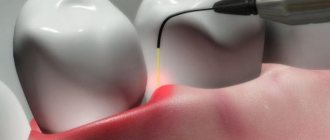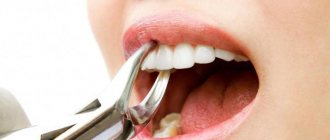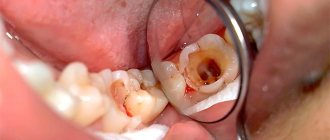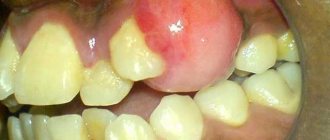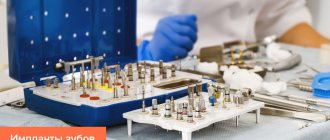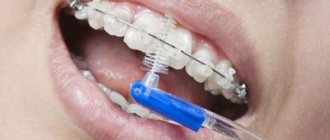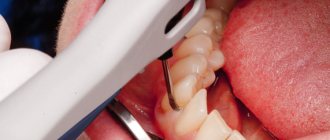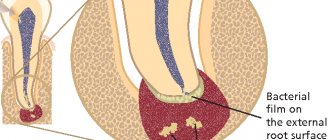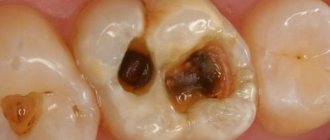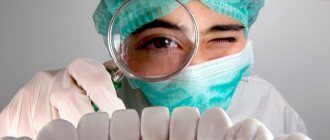The use of laser in dentistry helps to cope with such serious gum diseases as periodontitis and periodontal disease. The danger of these diseases is that, developing gradually, they cause significant harm, usually by the age of 45–55. It all starts with bleeding gums, then loosening of the teeth, and then the tooth no longer holds in the jaw and falls out. Thus, in a short time a person loses, if not all his teeth, then a significant part of them. This can be avoided by promptly seeking treatment from a periodontist.
The main focus of the treatment of periodontitis and periodontal disease is the fight against infection located in the gum pockets. In a healthy state, there is no pocket between the gum and tooth. The gum is dense, elastic, and fits well to the tooth. With periodontitis, the gum becomes inflamed, moves away from the tooth and a periodontal pocket forms, in which plaque teeming with bacteria accumulates. Treatment of periodontitis begins with cleaning out the periodontal pocket so that the gum adheres to the tooth as much as possible, but this is not easy to do, since the pockets are complex in shape and deep. If the periodontal pocket is not completely cleaned, then with a decrease in immunity and certain endocrine conditions, a recurrence of periodontitis may occur.
Features of laser exposure
At the age of 35-40 years, periodontal diseases occur in almost 90% of cases. 9 out of 10 adults suffer from periodontal disease. Even if changes in the gums are not visually detected, we must remember that the initial stages of periodontal disease are asymptomatic.
Only a doctor can make an accurate diagnosis and detect the first signs of damage. Therefore, it is so important to promptly seek help from a dentist to identify pathology.
Laser treatments for gum disease are not only highly effective, but also absolutely painless, as evidenced by numerous patient reviews.
Periodontal disease of 2 severity
Today, dentists use various models of laser systems. Their operating principle is almost the same. However, each type of light flux has its own purpose and specific functions. The principle of operation is to emit a light flux, which is electromagnetic waves with polarized and monochromatic qualities.
The beam is focused so that it precisely targets the problem area. The therapeutic effect is due to tissue changes at the molecular level. During exposure to laser flow, liquid particles evaporate, as they actively absorb electromagnetic waves from the emitter.
So-called micro-explosions are observed on the treated surfaces. They additionally help to destroy affected tissues and destroy pathogenic microorganisms. Moreover, the effect occurs precisely on the changed tissues. Healthy areas remain unharmed as they are further treated with water jet cooling.
Indications for laser treatment
Gingivitis
This is a common gum disease, the main cause of which is the accumulation of microbes. Thanks to the laser beam, the surface of the gums and periodontal pockets are cleaned. The procedure has a disinfecting effect, thanks to which the further development of the pathological process is prevented. After 2-3 days the patient feels relief.
From gingivitis to periodontitis
Periodontal disease
Laser treatment is effective in the treatment of periodontal disease of varying degrees. The procedure uses a carbon laser. The essence of treatment is the rapid elimination of all pathologically altered tissue and the formation of a surface that will heal quickly. The carbon laser effectively removes granulation and epithelium from the inner wall of the gum pockets, promoting a speedy recovery.
What is periodontal disease
Periodontitis
The essence of therapy is the introduction of laser light into the periodontal cavity. The supplied beam is capable of coagulating and disinfecting tissue. It has special depth indicators, thanks to which treatment is carried out throughout the entire depth of the periodontal pocket.
Removal of fibroids and hemangiomas of the gums
Laser treatment is one of the most effective methods for eliminating various growths on gum tissue. Thanks to it, there is no pain and discomfort, there is no need to administer an anesthetic, unlike surgery, and the rehabilitation process occurs quickly.
Removal of fistulas and granulomas
In this case, laser therapy is only part of a comprehensive treatment. It is used at the stage of root canal sterilization. It is carried out after opening the tooth, cleaning the canals and removing purulent contents.
Advantages of the technique
The use of laser is used in many areas of medicine. In dentistry, such treatment began to be used relatively recently. However, in a short period of time, the technology has found acceptance in this healing industry. All this is due to the unique properties inherent in laser radiation.
The advantages of the technique are as follows:
- lack of use of painkillers for manipulation;
- there is no need for surgical sutures, since there is a minimal level of trauma;
- there is no bleeding during the operation, or only a small amount is observed;
- there is virtually no risk of disease relapse;
- complete painlessness during the procedure and during the rehabilitation period;
- the possibility of a positive effect on all periodontal diseases;
- a minimum set of contraindications;
- there is no obvious wound area in the intervention area;
- there are possibilities for instant coagulation of vessels and overgrown periodontal tissues;
- absolute sterility of the procedure, since the operation is carried out in a non-contact manner;
- rapid regeneration and tissue restoration.
One disadvantage of the procedure is the high price. Moreover, it directly depends on the cost of the devices. Due to their high cost, many clinics are not able to provide such dental care.
What else is laser used for in dentistry?
Dentists also use laser therapy for:
- Reducing the sensitivity of enamel to temperature and tactile stimuli. The tooth is treated with a laser and then covered with ointment to preserve the result for a long time.
- Reducing the period of adaptation of the dentition to the braces system. Strengthening a displaced tooth in the jaw.
- Eruption of an impacted tooth.
- Prevention of alveolitis after tooth extraction, if the tissues have been severely damaged.
- Relieving the inflammatory reaction of the dental nerve during deep caries.
- Elimination of tartar and food deposits, bleeding gums.
Laser technologies are used in clinics of the President network, in the laser medicine clinic of Dr. Kolesnichenko, Khoroshevskaya dental clinic, Dentaljaz and others.
You can get complete information about the capital’s clinics that provide treatment, whitening and implantation using lasers on the MyDentist dental portal.
Indications and contraindications
Laser technology is used not only in the treatment of periodontal diseases. It has proven effective during endodontic intervention, in cases of enamel damage in the early stages of caries, as well as for fissure closure procedures.
The technique is actively used for the following gum diseases:
- all types of gingivitis;
- periodontal disease of varying severity;
- periodontitis;
- removal of hemangiomas and fibromas;
- carrying out sterilization of pockets;
- treatment of fistulas and granulomas.
Bleeding gums is one of the indications for laser use.
The active actions of the light flux are especially effective in the initial stages of gum disease.
Therefore, it is necessary to undergo a therapeutic course if the following symptoms appear:
- increased sensitivity of soft and hard tissues;
- bleeding gums;
- unnatural color of the periodontium, especially the marginal gum;
- the appearance of itching, swelling and sharp painful sensations;
- the presence of white or gray plaque on the oral mucosa;
- the appearance of purulent formations in the oral cavity;
- peeling of the gingival margin from the tooth crown;
- formation of pathological threes and diastemas.
Many of these symptoms indicate the onset of a serious disease such as periodontal disease. If the required amount of assistance is provided on time, the pathology can be stopped.
However, the use of this technology is not always allowed, despite the fact that it is the safest. If you are going to treat your gums with a laser, contraindications must be taken into account. Mostly they are relative, but some will be absolute.
As a rule, these are severe somatic diseases, such as:
- diabetes;
- tuberculosis;
- oncology even in the very first stages of development;
- post-infarction condition;
- suffered a stroke;
- recovery period after chemotherapy or laser irradiation.
To achieve the best results, you should follow all the dentist's recommendations. The instructions received from the doctor will be individual, depending on the severity of the pathological process and the general condition of the body.
Causes of periodontitis development
The development of periodontitis can be caused by various factors. According to long-term examinations conducted by American specialists, this occurs due to improper or insufficient dental care or immune failure in the body.
Studies have shown that deposits and plaque on teeth contain a huge number of harmful microorganisms that release toxic substances. This is what negatively affects the condition of the gums and dental tissue, and leads to their destruction.
Typically, the development of the disease begins with bleeding gums while brushing your teeth. Then pain is added to this symptom. Therefore, in the future, oral and dental hygiene will be carried out with special care and of insufficient quality. This will lead to an increase in the volume of dental plaque, which gradually turns into tartar. This environment is especially beneficial for the development of harmful microorganisms.
This situation will lead to even greater inflammation of the gums and deterioration of the periodontal condition. This will also have a negative impact on the blood vessels, causing tissue nutrition to decrease and the destructive process to accelerate.
Often the cause of periodontitis is a failure of the immune system. This happens due to frequent stress, trauma, and hormonal imbalance. Immune cells begin to perceive periodontal tissue as foreign, subjecting them to an active attack. As a result of such exposure, aseptic inflammation of the gingival tissue occurs and its subsequent death. Gradually, the negative process spreads to the bone tissue. After this, patients begin to notice loosening and then tooth loss.
These undesirable manifestations can be accelerated by the presence of other diseases and factors: diabetes, smoking, problems with the gastrointestinal tract, stressful situations, hormonal imbalances, advanced caries, malocclusion and poor-quality dentures.
Types of laser radiation
The photo shows a laser machine used in dentistry
For each pathology it is customary to use a certain light flux.
The following type of laser is most often used in dental practice:
- Diode. It is intended to affect soft tissue. In addition, this type of radiation provides enamel whitening and helps seal microtubules.
- Erbium. Used to remove dental plaque. It ensures the splitting of the stone, which after processing easily comes off on its own.
- CO2 laser. Indicated in the presence of inflammatory processes. The light flux actively affects soft tissues, ensures the removal of necrotic areas and provides coagulation in the event of even severe bleeding.
Professional opinion. Dentist-therapist of the highest category, 16 years of practical work, Nikolsky M.N.: “When treating periodontal diseases, the most important task is to fight infection. For example, with periodontitis, pathological pockets are formed in which pathogenic bacteria accumulate in large quantities.
It is quite difficult to achieve its cleansing using conventional antiseptics. In this case, very often the treatment is delayed, and the pathology relapses even after a positive effect. Laser radiation not only removes germs, but also breaks down dead tissue.
Unlike conventional surgery, the light flux does not affect healthy tissue. Even if an injury occurs, the laser reliably seals the vessels, preventing any postoperative bleeding.”
Treatment of periodontitis at home
To treat periodontitis at home, you first need to undergo a course of procedures at a dental clinic. Only after this is a set of measures prescribed to remove plaque from teeth and drugs to restore gum tissue.
These include:
- Regular brushing of teeth after each meal with Parodontax therapeutic periodontal paste, which can be used at any stage of the disease. To brush your teeth, it is recommended to use a Sensodyne medium toothbrush with medium-hard bristles. In the morning and evening you should use a thin and flexible dental brush;
- The use of an oral irrigator is a special device that cleans teeth and massages gums using a stream of water and air. At the same time, blood flow in the vessels improves, which has a beneficial effect on the condition of the periodontium, and inflammation of the gingival tissue is reduced. One of the best is the Braun Oral-B irrigator.
- Rinsing your mouth after meals using special rinses;
- Lubricating the gums with Asepta gum balm, which eliminates pain and inflammation, with a disinfecting and healing effect.
These products can only be used as prescribed by a doctor after the procedure for treating periodontitis with ultrasound and active prf regeneration proteins.
An integrated approach to clinical and home therapy allows for quick and lasting positive results.
Methods of influence
Thanks to the use of laser, several periodontal surgical operations are replaced. Three types of influence are most often used.
Deepithelialization
This technique allows you to restore not only the oral mucosa, but also the bone tissue of the alveolar process. During exposure, the affected areas of the epithelium are removed and the growth of connective tissue cells is ensured. Deepithelialization in most clinical cases is used in combination with targeted tissue regeneration.
This process is quite lengthy, but this is not its disadvantage. Thanks to the prolonged flow, the affected tissues are tightened and completely smoothed out. This effect is very important in the treatment of periodontal disease, since the main problem of the disease is sagging gum tissue. The effectiveness of the technique has been practically proven even in advanced forms of periodontal disease.
Gingivectomy
This is the so-called laser gum trimming. Infected and decaying gum tissue is excised, blocking the spread of infection. The procedure improves the aesthetics of the oral cavity and prevents the progression of periodontal diseases. At the same time, periodontal tissue is preserved as much as possible; the laser provides bloodless exposure.
After several sessions, periodontal pockets in which a huge number of bacteria accumulate are completely eliminated. At the end of the entire procedure, hemocoagulation and a bactericidal effect are ensured.
Laser curettage
This technique allows you to treat even the deepest gum pockets. The laser ensures the removal of anesthetized epithelium and granulation tissue.
Basically, laser curettage is aimed at removing harder pathological formations both in the gum pockets themselves and in the area of its entrance. The technique not only cleanses the deep layers of the periodontium, but also helps to minimize dietary restrictions during the rehabilitation period.
Laser treatment of gums using deep curettage method
Attention!!! The most important task of laser treatment of periodontal diseases is the restoration of periodontal and bone tissue of the alveolar process, as well as root cement. In addition, ensuring the normalization of trophism and accelerating the epithelization of damaged areas of the gums.
How to treat periodontitis with laser
An integrated approach is important in the successful treatment of periodontitis. The use of modern techniques allows you to eliminate inflammation and restore tissue damage.
At the same time, the German technique using a dental laser and injections of tissue regeneration factors prf is recognized as the best method. It is actively used in the largest clinics in Israel, the USA and European countries. In Moscow, specialists from the Bionic Dentis clinic were the first to introduce this technique into their practice.
